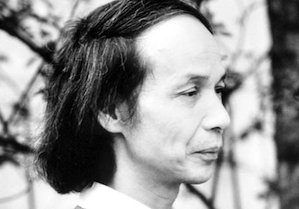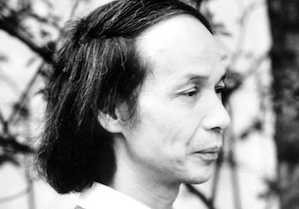
When Toru Takemitsu was a teenager, he was entranced by Western classical music he encountered on radio broadcasts from the American soldiers occupying his native Japan after World War II. The sound so beguiled him that he would wander the city, listening for the sound of a piano, and then he’d ask the piano player if he could just touch the piano for five minutes. He was never refused.
Takemitsu’s infatuation led the self-taught composer to investigate Arnold Schoenberg and the second Viennese school composers, and later Debussy (who was himself touched by Japanese aesthetics), Olivier Messiaen, and Cage. But by the 1960s, thanks in part to Cage’s own debt to Zen ideas, as well as seeing a performance of traditional Japanese bunraku puppet theater, Takemitsu began incorporating the Japanese music elements he’d long eschewed into his Western orchestral and chamber settings, creating evocative musical fusions that made him one of the 20th Century’s greatest composers. “I suddenly recognized I was Japanese,” he recalled. “I came to recognize the value of my own tradition.”
Best known in Japan for his hundred film scores (including several for the films of the great director Akira Kurosawa), he eventually taught at Yale and other universities around the world and was awarded some of classical music’s most prestigious honors before his death in 1996. By then, his music had flowered into a sturdy hybrid that sounded like nothing else. Just before he died, the composer dreamed that he was a whale swimming in an ocean that had no east and no west.
Like many who discover Takemitsu’s music, and like Takemitsu himself, Susan Waterfall also came to his music via the portal of Western classical music. After a deep immersion in the music of Messiaen, she picked up the score of Takemitsu’s delicate Rain Tree Sketches, and discovered “an amazing composer who goes beyond Messiaen,” she recalls. “His scores are so deep on so many levels.”
On July 21, Waterfall will lead visitors to the 27th Mendocino Music Festival along a similar path from Western classical music to Takemitsu’s striking, Asian-tinged sounds via a multimedia presentation called The Life & Legacy of Toru Takemitsu.
Waterfall’s program concentrates on Takemitsu’s chamber music, with a special emphasis on guitar (including his arrangement of Gershwin’s “Summertime”), thanks to the presence of guest artist guitarist Shin-Ichi Fukuda, who’s recorded Takemitsu’s music, and who’ll also perform the composer’s guitar concerto To the Edge of Dream with the festival orchestra on July 24. Waterfall, a pianist, and her son, the jazz pianist Julian Waterfall Pollack, will play a pair of Takemitsu’s solo piano works.
“I suddenly recognized I was Japanese. I came to recognize the value of my own tradition.” - composer Toru Takemitsu
Waterfall co-founded the festival in 1986 with her husband, Allan Pollack (the festival’s music director, a composer and jazz saxophonist who also directs the Symphony of the Redwoods and Sacramento’s Camellia Symphony Orchestra) and the late San Francisco Symphony bassoonist Walter Green. She’s produced a baker’s dozen such “narrated chamber music” shows covering everything from Argentine composers to music of the Holocaust to the Parisian music scene to last season’s contemporary Chinese music program.
As usual, this summer’s Mendocino festival, which runs July 13-27, includes a wide range of music, such as this summer’s concerts featuring Hot Tuna/ Jefferson Airplane guitarist Jorma Kaukonen and banjo master Alison Brown’s quartet, plus jazz, world music, a cappella rock, solo piano by Gloria Cheng and others, Irish, Afro-Cuban music, full orchestra concerts, plus lecture recitals, workshops, even a dinner party.
Understanding his connection to nature is crucial to appreciating Takemitsu’s unique sound world, less linear and more atmospheric than much of the Western music that preceded it.
The evening Takemitsu production is the culminating event in the festival's daylong Umi no Hi: A Celebration of Japan’s Ocean Day, a Japanese national holiday, which includes haiku readings, taiko drum performances, and other Japanese traditional music.
At the traditional music performance that afternoon, “people can hear how all the Japanese instruments are so involved in timbre” (quality of tone), Waterfall explains.
In discovering Takemitsu’s music, she marveled at how the composer embraced that aesthetic by deploying “little, simple, melodic motifs and fragments and dissonances to create timbre,” she says. “He uses these composed resonances to create a natural world parallel to the one Western music is based on.”
Understanding his connection to nature is crucial to appreciating Takemitsu’s unique sound world, less linear and more atmospheric than much of the Western music that preceded it.
“Even though he'd mastered Western musical culture,” Waterfall says, Takemitsu “ended up embracing Japanese artistic values. To the Japanese, nature and beauty are the same concept. John Cage said that Takemitsu transformed nature into music.” Her presentation will also guide listeners through the composer’s life and the cultural context surrounding his music — including images from the largest Japanese garden outside Japan, in Portland, Oregon.
“My music is like a garden, and I am the gardener,” Takemitsu wrote. “Listening to my music can be compared with walking through a garden and experiencing the changes in light, pattern and texture.”

